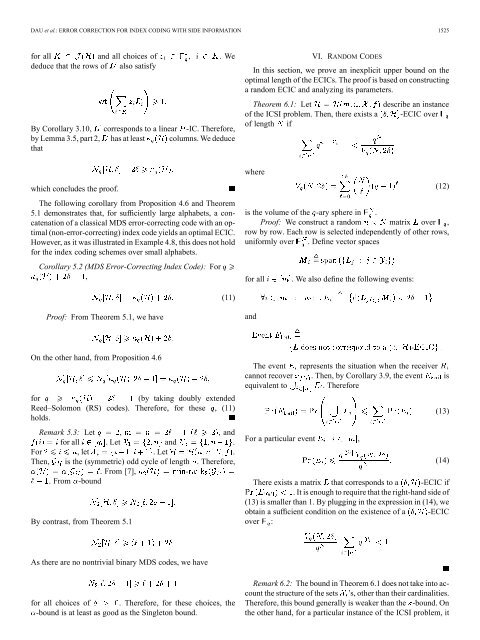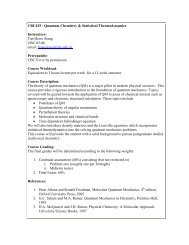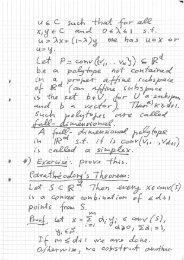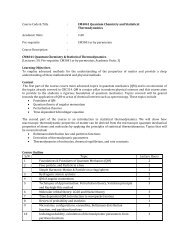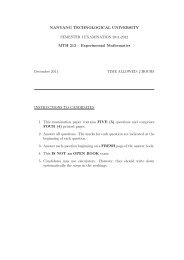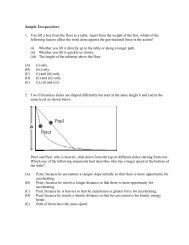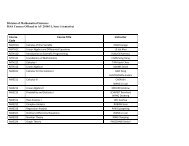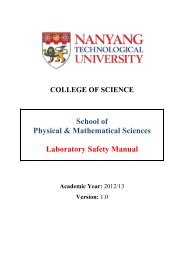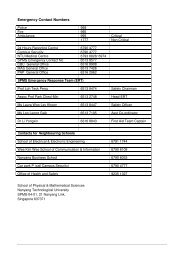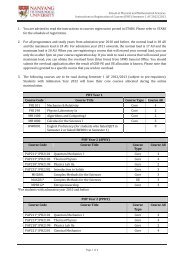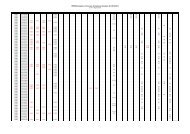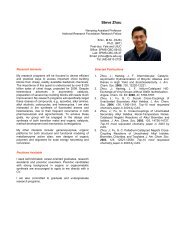Error Correction for Index Coding With Side Information - Spms
Error Correction for Index Coding With Side Information - Spms
Error Correction for Index Coding With Side Information - Spms
Create successful ePaper yourself
Turn your PDF publications into a flip-book with our unique Google optimized e-Paper software.
DAU et al.: ERROR CORRECTION FOR INDEX CODING WITH SIDE INFORMATION 1525<strong>for</strong> all and all choices of .Wededuce that the rows of also satisfyBy Corollary 3.10, corresponds to a linear -IC. There<strong>for</strong>e,by Lemma 3.5, part 2, has at least columns. We deducethatVI. RANDOM CODESIn this section, we prove an inexplicit upper bound on theoptimal length of the ECICs. The proof is based on constructinga random ECIC and analyzing its parameters.Theorem 6.1: Letof the ICSI problem. Then, there exists aof length ifdescribe an instance-ECIC overwhich concludes the proof.The following corollary from Proposition 4.6 and Theorem5.1 demonstrates that, <strong>for</strong> sufficiently large alphabets, a concatenationof a classical MDS error-correctingcodewithanoptimal(non-error-correcting) index code yields an optimal ECIC.However, as it was illustrated in Example 4.8, this does not hold<strong>for</strong> the index coding schemes over small alphabets.Corollary 5.2 (MDS <strong>Error</strong>-Correcting <strong>Index</strong> Code): For,where(12)is the volume of the -ary sphere in .Proof: We construct a random matrix over ,row by row. Each row is selected independently of other rows,uni<strong>for</strong>mly over .Define vector spaces<strong>for</strong> all.Wealsodefine the following events:(11)Proof: From Theorem 5.1, we haveandOn the other hand, from Proposition 4.6<strong>for</strong>(by taking doubly extendedReed–Solomon (RS) codes). There<strong>for</strong>e, <strong>for</strong> these , (11)holds.Remark 5.3: Let , ,and<strong>for</strong> all .Let and .For ,let .Let .Then, is the (symmetric) odd cycle of length . There<strong>for</strong>e,.From[7],.From -boundBy contrast, from Theorem 5.1The event represents the situation when the receivercannot recover . Then, by Corollary 3.9, the event isequivalent to . There<strong>for</strong>eFor a particular event ,(13)(14)There exists a matrix that corresponds to a -ECIC if. It is enough to require that the right-hand side of(13) is smaller than 1. By plugging in the expression in (14), weobtain a sufficient condition on the existence of a -ECICover :As there are no nontrivial binary MDS codes, we have<strong>for</strong> all choices of . There<strong>for</strong>e, <strong>for</strong> these choices, the-bound is at least as good as the Singleton bound.Remark 6.2: The bound in Theorem 6.1 does not take into accountthe structure of the sets ’s, other than their cardinalities.There<strong>for</strong>e, this bound generally is weaker than the -bound. Onthe other hand, <strong>for</strong> a particular instance of the ICSI problem, it


